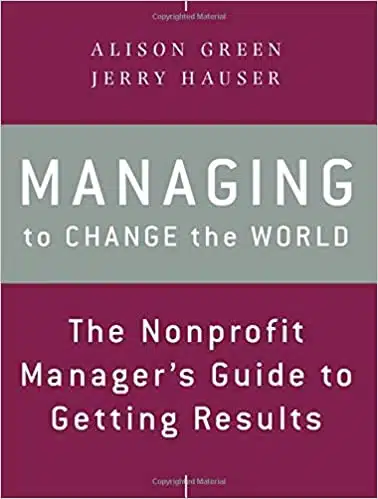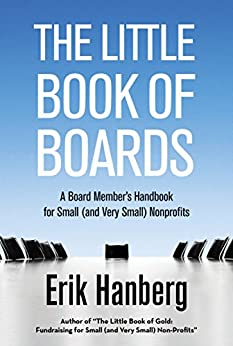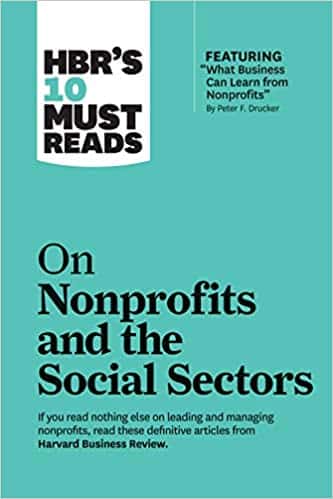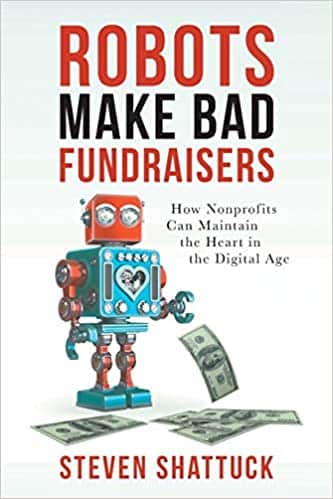You found our list of helpful nonprofit books.
Nonprofit books are guides that teach readers how to start and effectively run philanthropies. These works cover topics like fundraising, leadership best practices, legal and tax structures, and ways to market the mission. The purpose of these books is to help nonprofits be more organized and maximize impact.
These works are similar to business books, office management books, and HR books.
This list includes:
- nonprofit marketing books
- nonprofit operations books
- books on nonprofit fundraising
- books on how to start a nonprofit
- nonprofit management books
- nonprofit leadership books
Here we go!
List of nonprofit books
From nonprofit fundraising books to board member handbooks, here is a list of guides to help maximize social impact.
1. The Networked Nonprofit: Connecting with Social Media to Drive Change by Beth Kantor

The Networked Nonprofit is one of the best nonprofit marketing books. This handy guide teaches readers how to leverage social media to build relationships, spread awareness, and ultimately secure more funding and support. The book explains how organizers can use social platforms to deliver important messages, spark interest in the cause, and spur action. The Networked Nonprofit is one part digital marketing tutorial, one part social media activism masterclass.
Notable Quote: “One constant in life is that human beings want and need to connect with one another in meaningful ways. These connections are made through social networks that are the conduits for the conversations that power social change. The job of nonprofit organizations is to catalyze and manage those conversations.”
2. The Only Grant-Writing Book You’ll Ever Need by Ellen Karsh

The Only Grant-Writing Book You’ll Ever Need is one of the most popular nonprofit fundraising books. This guide explains different types of grants, and grantmakers, the proposal process, and application requirements. The author also dispels common myths and misconceptions about grants and gives readers accurate expectations for applying. The latter half of the book breaks down the writing procedure into simple steps and provides tips to increase the chances of receiving funding. True to its name, The Only Grant-Writing Book You’ll Ever Need provides the most comprehensive advice on getting grants and turns readers into master writers.
Notable Quote: “Submitting a poorly-thought out, poorly developed, poorly written proposal is sometimes the most damaging thing you can do to your long-term prospects.”
Buy The Only Grant-Writing Book You’ll Ever Need.
Get our free team building toolbox
- icebreaker games
- bingo cards
- DIY guides
 by teams at FedEx, Amazon, Deloitte and 73,930+ others
by teams at FedEx, Amazon, Deloitte and 73,930+ others

3. Nonprofit Kit For Dummies by Stan Hutton and Frances N. Phillips

Nonprofit Kit for Dummies is one of the most useful nonprofit operations books. This guide is a philanthropy encyclopedia that covers subjects like mission statements, tax exemptions, financial forecasting, promotion, hiring and volunteer recruiting, and adapting to change. The book lays out strategies for every circumstance and defines all nonprofit terms in simple language. Nonprofit Kit for Dummies is a complete crash course in launching and running a philanthropy and can make a novice a nonprofit expert in no time.
Notable Quote: “You should always begin with a plan, but that doesn’t mean that plans shouldn’t be altered when the situation calls for it. Circumstances change; flexibility and adaptability are good traits to nurture if you’re running a nonprofit organization.”
Buy Nonprofit Kit For Dummies.
4. Managing to Change the World: The Nonprofit Manager’s Guide to Getting Results by Alison Green and Jerry Hauser

This guide is one of the best nonprofit management books. Managing to Change the World passes on leadership strategies and team management skills for bosses in the nonprofit sector. The book lays out tactics for attracting and retaining talent, giving performance reviews, building a healthy company culture, and finding a balance between authority and empathy. Managing to Change the World delivers basic management tips alongside targeted advice aimed at the nonprofit sector. This book is ideal for any philanthropist hoping to become a better boss.
Notable Quote: “By being clear about what you expect, helping people meet your expectations, ensuring people are in roles in which they excel, and getting everyone aligned around a common purpose, you’ll build your staff’s morale in the long run. Treating people well also happens to be the best way to sustain your results over the long haul, because you’ll never get good people to work for you otherwise.”
Buy Managing to Change the World, and check out more books on management.
5. Forces for Good: The Six Practices of High-Impact Nonprofits by Leslie Crutchfield

Forces for Good is a playbook for building a high-performing nonprofit. The book identifies six patterns and practices that make organizations successful, such as nurturing nonprofit networks and sharing leadership duties. The authors use examples and case studies from some of the most well-known and successful nonprofits in the country, like Habitat for Humanity and The Heritage Foundation. Forces for Good shows nonprofit leaders how to bring about major social change and achieve sustained results.
Notable Quote: “Too many people still act as if the private sector and the non-profit sector should operate on opposite sides of an impenetrable wall, where one is all about making money and the other about serving society. A better approach is to take the best of both worlds and integrate these missions: businesses can be “not only for profit” and social-service organizations can learn from the business sector’s best practices, including leveraging capital to maximize scalability and sustainability.”
Buy Forces for Good.
6. Start Something That Matters by Blake Mycoskie

Start Something That Matters is one of the most interesting books on starting nonprofits. This memoir tells the story of Blake Mycoskie, founder of TOMS, the company that popularized the “buy one and we’ll donate one” business model. The book does not deal exclusively with nonprofits, but rather encourages aspiring difference-makers in all arenas to start projects that do social good. Blake Mycoskie insists that the key to finding fulfillment at work is to undertake endeavors that you are passionate about and that have impact on others. The book teaches readers how to build a narrative, be resourceful and adaptable, and build trust and relationships with supporters– all skills that are vital to the nonprofit sector. Start Something That Matters blurs the line between the corporate and philanthropy worlds and urgers members in any sector to be both business-savvy and giving.
Notable Quote: “No matter how convenient it is for us to reach out to people remotely, sometimes the most important task is to show up in person.”
Buy Start Something That Matters.
7. Joan Garry’s Guide to Nonprofit Leadership: Because the World Is Counting on You by Joan Garry

This book is one of the bestselling nonprofit leadership books. Joan Garry’s Guide to Nonprofit Leadership shows organizational heads how to craft compelling pitches, find harmony amongst board members, empower staff, and navigate crises. Joan Garry outlines the unique challenges of nonprofit leadership and gives guidance on getting results, earning respect, and achieving the organization’s vision. This latest edition of the book has been updated to address recent global events like the pandemic, and analyzes how leaders can respond to environmental changes while still serving the organization’s vision.
Notable Quote: “In the nonprofit sector a leader is beholden to vast and diverse stakeholders….The bottom line matters, of course, but only to ensure that you have sufficient resources to work in the service of your mission.”
Buy Joan Garry’s Guide to Nonprofit Leadership.
8. Fundraising for Social Change by Kim Klein

Fundraising for Social Change is a textbook that teaches readers strategies for securing financial backing for nonprofits. The book covers all the ins-and-outs of finding money for organizational missions. For example, diversifying donor bases, tapping endowments and reserves, crafting captivating appeals, and using multi-channel fundraising approaches. The textbook also delves into concepts such as budgeting, working with fundraising consultants, and navigating ethical donor dilemmas. Fundraising for Social Change covers the basics of nonprofit funding in great detail and is a valuable resource for any organization looking to begin raising money or shake up the typical fundraising routine.
Notable Quote: “Not asking what kind of funding streams are most mission fulfilling is the root of many of our social problems.”
Buy Fundraising for Social Change.
9. The Little Book of Boards: A Board Member’s Handbook for Small (and Very Small) Nonprofits by Eric Hanberg

The Little Book of Boards is one of the best nonprofit books for small organizations. The book functions as a handbook for first-time board members unfamiliar with the many nuances of heading an organization. This resource outlines the roles of board members and various specific positions, meeting protocols, non-meeting responsibilities, committee structures, and techniques for building a strong board. The Little Book of Boards can help organizations create or revamp operational structure and form a more streamlined and efficient management system.
Notable Quote: “Board members at small nonprofits are often highly engaged in the work of the organization, often by necessity. They may even be essential to its work and continued operation, making up the core of a group of volunteers and doing the actual work of the nonprofit.”
Buy The Little Book of Boards.
10. Start A 501c3 Nonprofit That Doesn’t Ruin Your Life: How to Legally Structure Your Nonprofit to Avoid I.R.S. Trouble, Lawsuits, Financial Scandals & More!

Start A 501c3 Nonprofit That Doesn’t Ruin Your Life is a nuts and bolts guide to the legal and business structural aspects of nonprofits. The guide tackles topics like following proper IRS protocols, trademarks, avoiding liability and lawsuits, taxes, and building a board. The book structures information into digestible, indexed chapters that are easy to reference as needed. Start A 501c3 Nonprofit That Doesn’t Ruin Your Life is the ultimate guide to the bureaucratic side of philanthropy.
Notable Quote: “Almost everyone at some point has felt the feeling of disappointment when listening to the news and hearing about yet another nonprofit scandal. The good news is that this does not have to be your story. There are plenty of successful nonprofits that have been able to operate and enjoy good reputations while remaining above reproach.”
Buy Start A 501c3 Nonprofit That Doesn’t Ruin Your Life.
11. Social Startup Success: How the Best Nonprofits Launch, Scale Up, and Make a Difference by Kathleen Kelly Janus

Social Startup Success is one of the most helpful books on how to start a nonprofit. Having surveyed hundreds of the most successful philanthropies, Kathleen Kelly Janus outlines five main strategies for high-growth and financial stability:
- testing ideas
- measuring impact
- funding experimentation
- leading collaboratively
- telling compelling stories
The book gives examples and instructions for each strategy, and covers concepts such as funding experimentation, data best practices, collaborative leadership, and narrative mastery. Social Startup Success provides a blueprint for creating a startup-like nonprofit that makes big change quickly and achieves longevity.
Notable Quote: “For some organizations, a small budget is sufficient to sustain their operations and be highly impactful. Scaling revenue also does not necessarily equate to scaling impact; an organization can be very good at raising money with programs that aren’t really making a significant difference. But many organizations that have the potential to do a great deal more good by scaling, and that are trying to grow faster, are stymied.”
12. HBR’s 10 Must Reads on Nonprofits and the Social Sectors by The Harvard Business Review

HBR’s 10 Must Reads on Nonprofits is an anthology of the publication’s most thought-provoking pieces on philanthropy. The collection covers areas such as choosing an addressable problem, measuring the impact of ideas, and reaching and properly ministering to communities in need. The book contains the essay “What Business Can Learn From Nonprofits” from management guru Peter Drucker, as well as interviews with influential humanitarians like Desmond Tutu and Salman Khan.
Notable Quote: “Most of the nonprofits operating today make program decisions based on a mission rather than on a strategy….Acting without a clear long term strategy can stretch an agency’s core capabilities and push it in unintended directions.”
Buy HBR’s 10 Must Reads on Nonprofits and the Social Sectors.
13. The Happy, Healthy Nonprofit: Strategies for Impact without Burnout by Beth Kanter and Aliza Sherman

Burnout is an epidemic in the nonprofit sector. Driven by a mission, leaders and nonprofit team members often run themselves and their staff ragged in an effort to serve the cause at all times. The Happy, Healthy Nonprofit is a handbook for avoiding compassion fatigue and employee turnover in nonprofit organizations. The book outlines the signs and causes of burnout, prescribes strategies for self-care, and gives recommendations on how to create a culture that prioritizes and is proactive about employee wellbeing.
Notable Quote: “An organization might be mission based, but its people are mission critical.”
Buy The Happy, Healthy Nonprofit.
14. Robots Make Bad Fundraisers: How Nonprofits Can Maintain the Heart in the Digital Age by Steven Shattuck

Robots Make Bad Fundraisers is one of the most helpful books on nonprofit fundraising. Technology has made it easier than ever before to reach potential donors, however, automating fundraising through tools and apps may not be the most effective strategy. Nonprofit financing still requires connection and a human touch. Steven Shattuck argues that modern tools should be a complement to traditional fundraising methods, not a replacement for them. Robots Make Bad Fundraisers explores topics such as donor management software, search engine optimization, email marketing, and social media, and shows ways nonprofits can optimize these channels to send warmer, more organic communications that bring about more support for the organization.
Notable Quote: “Technology works best when it enables relationship-building, instead of taking its place.”
Buy Robots Make Bad Fundraisers.
Final Thoughts
Individuals tend to start nonprofits with honest intentions and dreams of changing the world, yet are often unaware of the finer points of effectively running a philanthropy. The nonprofit world can be chaotic. Organizations often scramble and hustle constantly to find funding, and responding to disasters can add an extra sense of urgency. The world is full of need, and philanthropic leaders may feel that there is not enough time or funding to properly address urgent issues. However, reading these guides can help nonprofit employees better structure the organization and strategize to make maximum impact with modest resources.
Next, check out this list of virtual fundraising ideas and this guide to online volunteering.
We also have a list of the best business finance books.




